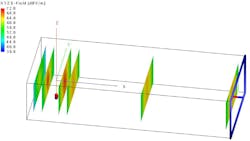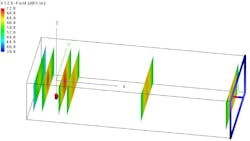How Can 3D-Printed Plastic Waveguides Enable V-Band Applications? (.PDF Download)
Waveguides structures have been well known for ages. Proposed by J.J. Thomson in 1893 and formally calculated by Lord Rayleigh a couple years later, they have been used heavily since World War II in a wide range of microwave and millimeter-wave (mmWave) applications. Such applications include radar, military and civil transmissions, aerospace and satellites, industrial ovens, etc.
The benefits of waveguides over coaxial transmission lines are numerous, but two standouts are very low loss and high power-handling capabilities. The guided wave propagation theory is also well-known, with the ubiquitous transverse-electric (TE) and transverse-magnetic (TM) propagation modes and associated cutoff frequencies, depending on waveguide dimensions (Fig. 1).
1. This is an example of a plane wave propagation in a waveguide (simulated here with FEKO).

